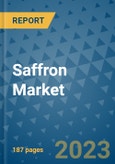The global saffron market is experiencing a resurgence, fueled by increasing awareness of its health benefits and rising demand in both culinary and non-culinary sectors. With applications ranging from gourmet cooking to natural skincare and nutraceuticals, saffron is becoming a preferred choice among health-conscious consumers and premium brands alike.
This product will be delivered within 1-3 business days.
Market Insights
The saffron market is projected to reach a valuation of US$ 496.91 million in 2025 and is expected to attain US$ 790 million by 2032, expanding at a CAGR of 7% during the forecast period (2025-2032). This growth is attributed to the global trend toward natural and functional products, as saffron is widely recognized for its antioxidant, anti-inflammatory, and mood-enhancing properties.Key Growth Drivers
- Health and Wellness Trends: Consumers are increasingly turning to saffron-infused teas, supplements, and functional foods for their natural health benefits.
- Culinary Applications: Saffron continues to be a key ingredient in traditional dishes across Indian, Persian, and Spanish cuisines, boosting its global culinary appeal.
- Cosmetics and Personal Care: The cosmetics industry is incorporating saffron into skincare products for its rejuvenating and anti-aging effects.
- Natural Food Coloring: As manufacturers shift away from synthetic additives, saffron is being adopted as a premium natural food colorant.
- Regulatory Assurance: Adherence to ISO 3632 standards enhances consumer confidence by protecting against adulterated saffron products.
Business Opportunities
- B2B Growth: The business-to-business (B2B) segment is expected to dominate the saffron market due to bulk purchasing by food, pharmaceutical, and cosmetic industries. Partnerships and bulk transactions through platforms like Alibaba are streamlining global saffron distribution.
- Technological Advancements: Cutting-edge techniques, such as AI-driven quality assurance and blockchain-based traceability systems, are enhancing product transparency and trust.
- R&D and Controlled Cultivation: Innovations in aeroponics and CEA (Controlled Environment Agriculture) are allowing for higher yields and better quality saffron, especially in non-traditional cultivation areas.
Regional Analysis
- North America: Set to account for a significant market share, North America is witnessing a surge in saffron demand, particularly in the U.S., due to its use in gourmet products and health supplements. Domestic cultivation is emerging in regions like Vermont and Pennsylvania, aiming to ensure supply-chain efficiency.
- Asia Pacific: Countries such as India and Iran are leveraging their traditional saffron-growing expertise, while the cosmetics sector is creating new avenues for growth. Brands like Forest Essentials and Tata Consumer Products are leading with saffron-based offerings.
- Europe and Middle East: These regions continue to be major producers and consumers of saffron, particularly for culinary use and pharmaceutical applications.
Competitive Analysis
Key players in the saffron market are actively investing in product development, marketing campaigns, and strategic partnerships to expand their global presence. Companies are focusing on sustainability, authenticity, and premium packaging to differentiate their offerings. Some notable developments include:- Tata Consumer Products launching high-grade Kashmiri saffron with AI-enabled quality checks
- Gohar Saffron partnering with cosmetic companies to expand distribution
- Starbucks India introducing saffron-infused beverages in collaboration with local confectionery brands
- LNS AgriTech deploying aeroponic cultivation methods in India to combat climate challenges
- Saffron Tech initiating pilot facilities for advanced saffron farming using automated systems
Market Challenges
- Climate Change: Saffron cultivation is vulnerable to unpredictable weather patterns, impacting yields in traditional producing regions like Iran and Kashmir.
- Adulteration and Fraud: The presence of counterfeit products continues to threaten market trust, prompting companies to adopt DNA authentication and international certifications.
Key Market Opportunities
- Development of saffron-based nutraceutical products catering to mental health and wellness
- Expansion of saffron's use in high-end foodservice and cosmetic industries
- Emergence of smart farming technologies to improve yield and sustainability
Saffron Market Segmentation
By Form
- Thread
- Powder
- Liquid
By End Use
- Retail
- Food Service
- Culinary Products
- Dairy Products
- Confectionery
- Tea
- Others
By Function
- Flavoring & Spice
- Herbs
- Others
By Application
- Food Supplements
- Cosmetics
- Personal Care Products
- Food & Beverage
- Others
By Distribution Channel
- Business to Business
- Business to Consumers
By Region
- North America
- Europe
- Asia Pacific
- Latin America
- Middle East and Africa
This product will be delivered within 1-3 business days.
Table of Contents
1. Executive Summary
2. Market Overview
3. Global Saffron Market Outlook, 2019 - 2032
4. North America Saffron Market Outlook, 2019 - 2032
5. Europe Saffron Market Outlook, 2019 - 2032
6. Asia Pacific Saffron Market Outlook, 2019 - 2032
7. Latin America Saffron Market Outlook, 2019 - 2032
8. Middle East & Africa Saffron Market Outlook, 2019 - 2032
9. Competitive Landscape
10. Appendix
Companies Mentioned
- Safrante Global Company S.L.U.
- Evolva
- Rowhani Saffron Co
- Sara Nuts
- Tarvand Saffron Co
- Hijos de Eustaquio Abad & Co. S.L.
- USMS Saffron Co. Inc.
- Royal Saffron Company
- Saharkhiz International Group Companies
- Gohar Saffron
- Novin Saffron Co.
- Azafranes Manchegos SL
Methodology

LOADING...








